Overview
The article highlights the critical role of seven AI-based land records classification tools designed to enhance title research by automating and streamlining various facets of the process. These innovative tools—including automated document processing, AI-driven classification systems, and risk assessment technologies—collectively elevate efficiency and accuracy in managing land records. Industry professionals have reported significant reductions in manual errors and processing times, underscoring the transformative impact of these solutions on the field.
Introduction
The landscape of title research is experiencing a seismic shift, fueled by the integration of artificial intelligence and automation. As property professionals strive to enhance efficiency and accuracy, AI-based land records classification tools are emerging as indispensable assets in the pursuit of streamlined research processes. However, with the promise of automation comes the challenge of navigating potential risks and ensuring data integrity.
How can industry players leverage these innovative technologies while safeguarding against pitfalls in this rapidly evolving environment?
Parse AI: Advanced Machine Learning for Title Research Automation
Parse AI harnesses advanced machine learning algorithms and ai-based land records classification tools to automate the extraction of crucial details from property records, significantly enhancing the research process. This innovative technology minimizes the time and effort traditionally required, empowering professionals to focus on more strategic, high-value tasks.
By consistently adapting to user engagements and diverse document categories, Parse AI enhances its precision and effectiveness, establishing itself as an essential tool for researchers. Notably, 90% of property and escrow specialists have embraced ai-based land records classification tools, indicating a substantial shift towards automation in the sector.
Furthermore, industry leaders highlight that ai-based land records classification tools are expected to generate enhanced operational efficiency and stability, enabling escrow firms to adapt to future market changes. Additionally, effective document naming conventions facilitated by Parse AI improve organizational efficiency and mitigate the risk of misfiled documents.
However, it is essential to remain cognizant of potential risks associated with AI adoption, such as increased fraud, to ensure a balanced approach to its integration in ownership research.
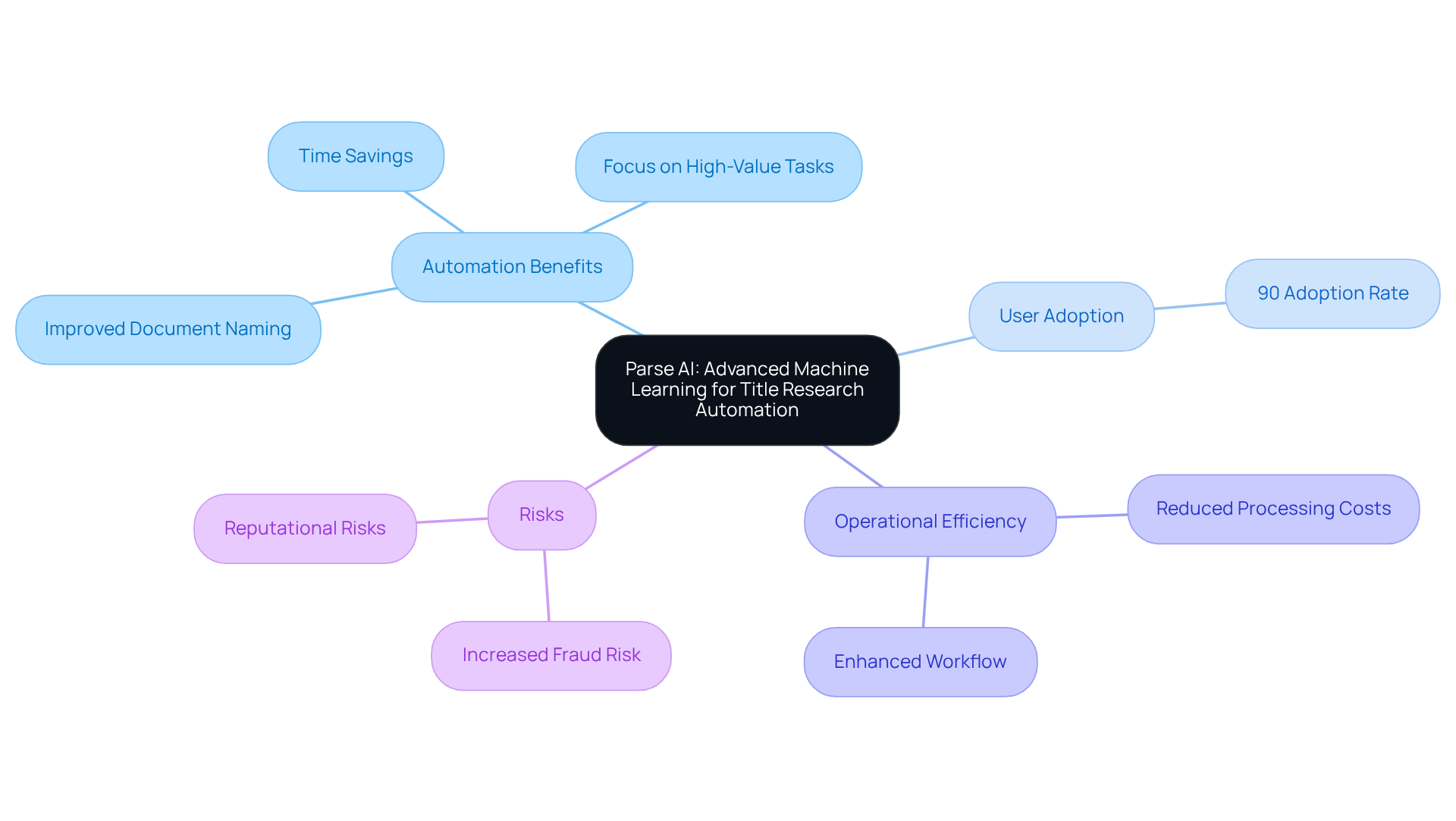
Digital Interface for Searching Comanche County Clerk Records: Streamlined Access to Land Records
The digital interface for searching Comanche County Clerk records establishes a user-friendly platform that significantly simplifies access to essential land records. By integrating advanced search functionalities and intuitive navigation, users can swiftly locate the information they require, thereby reducing the time spent on manual searches. This streamlined access proves particularly advantageous for title researchers, who depend on timely and precise information to finalize their reports effectively.
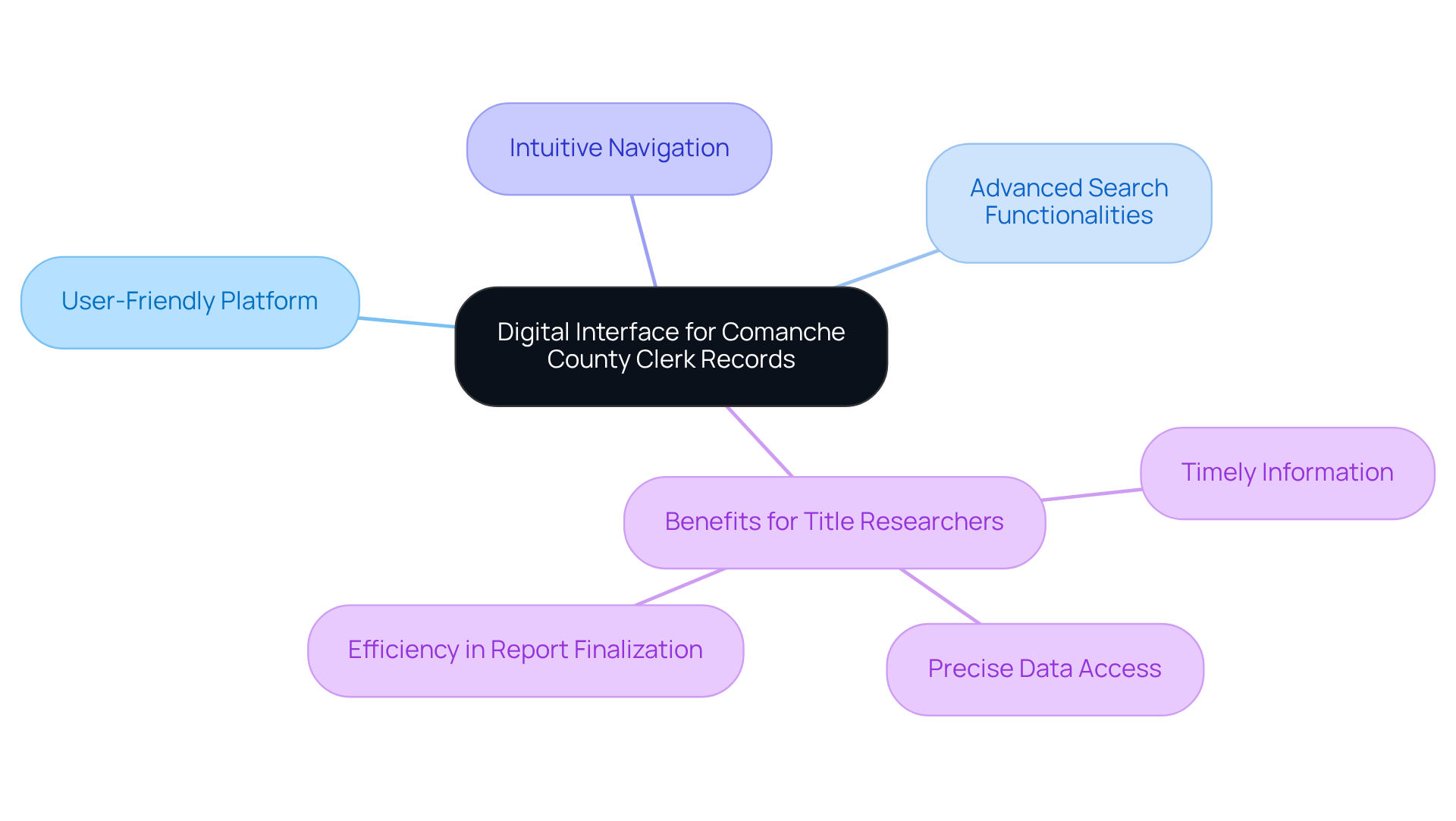
Automated Document Processing for Landmen: Leveraging OCR Technology for Enhanced Accuracy
The automated processing of files, powered by Optical Character Recognition (OCR) technology, allows landmen to convert scanned materials into editable and searchable formats. This innovation significantly enhances precision, reducing human errors in information entry. Studies indicate that manual entry has an error rate of approximately 1%, while automation can decrease these rates by up to 80%.
Furthermore, by simplifying the retrieval of pertinent information from property records, landmen can expedite their workflows, ensuring they utilize the most reliable data available. For instance, a logistics company that adopted advanced OCR solutions saw its document processing time drop from over seven minutes per file to under 30 seconds, exemplifying the efficiency gains possible through automation.
As the industry evolves, ongoing advancements in OCR technology continue to enhance its functionalities, establishing it as an indispensable resource for research professionals. Notably, the average individual makes about one error for every 1,000 routine activities, underscoring the critical need to minimize human mistakes in research.
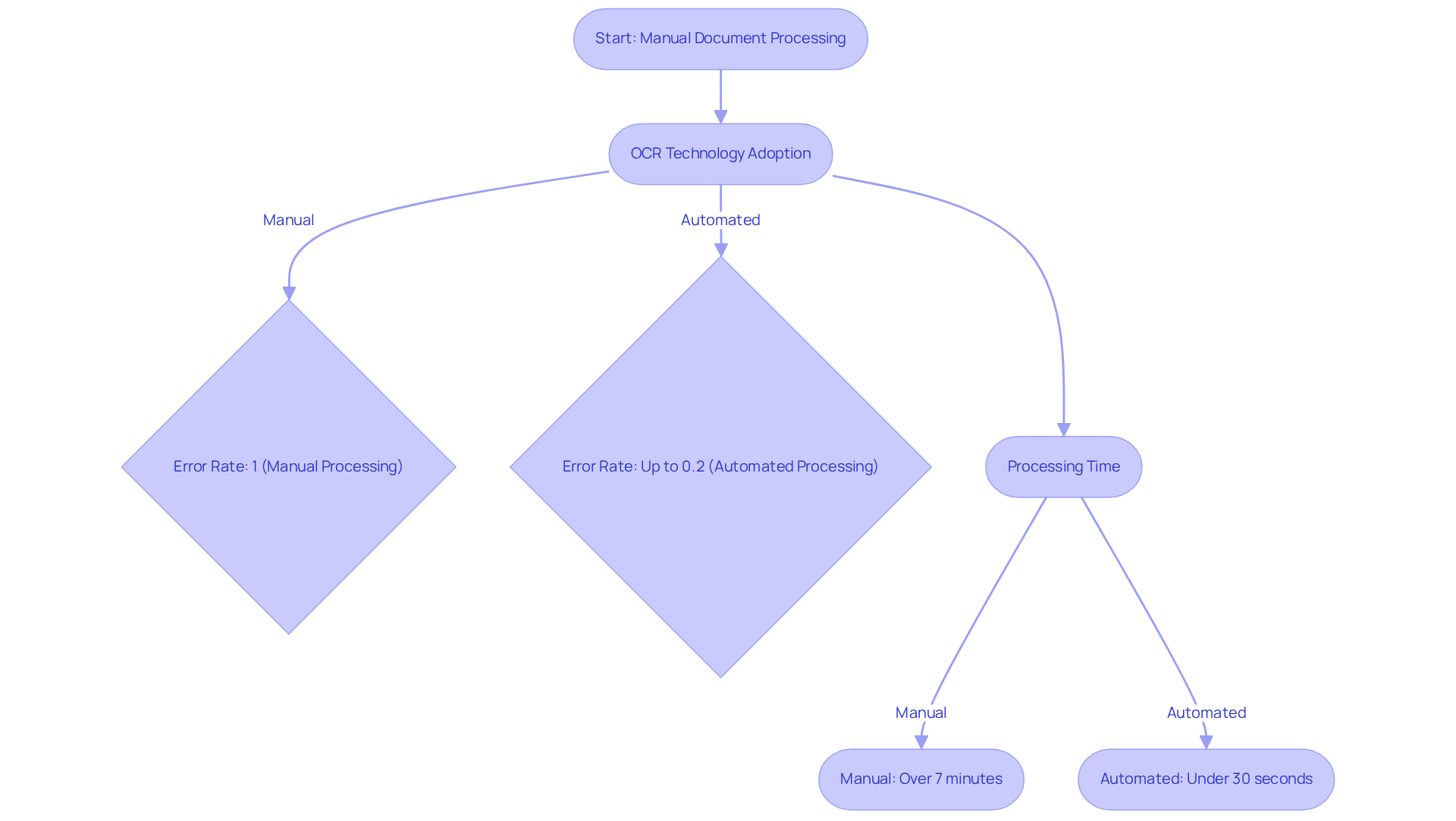
AI-Powered Document Classification System: Efficient Categorization of Land Records
An AI-driven record classification system that incorporates AI-based land records classification tools automates the categorization of land files, enabling researchers to swiftly locate pertinent materials based on predefined criteria. This system significantly reduces the time spent on manual sorting and enhances the overall efficiency of the title research process. By harnessing machine learning, the classification system continuously improves its precision, adapting to new types of files and evolving user requirements.
As we approach 2025, the trend towards automated categorization is poised to accelerate, with nearly 90% of organizations planning to scale automation initiatives enterprise-wide in the next 2-3 years. Success stories abound; for instance, an engineering company experienced a 400% increase in requests for proposals after adopting intelligent data processing (IDP) solutions, underscoring the tangible advantages of automation.
Furthermore, with 80-90% of new data in enterprises being unstructured, the demand for effective AI-based land records classification tools to manage this data has become more critical than ever. Industry experts emphasize the importance of efficiency in classification, highlighting the transformative role of AI-based land records classification tools in modernizing workflows.
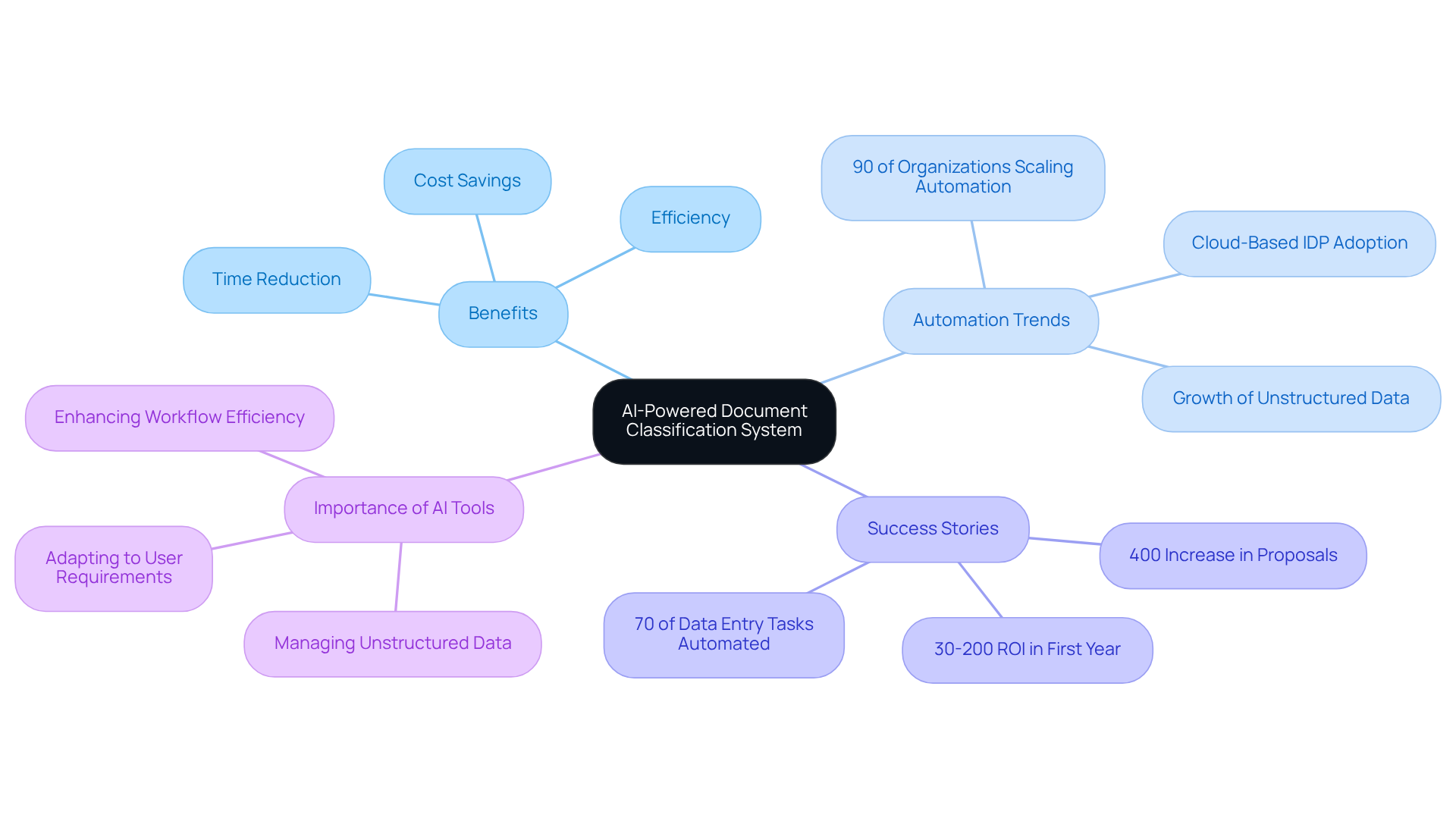
Land Record Management Software: Comprehensive Solutions for Title Research
Land record management software serves as an essential resource for property investigators, offering a comprehensive solution that encompasses document storage, retrieval, and analysis features. These systems are equipped with automated alerts for updates on land records, ensuring users access the most current information available.
By centralizing all relevant data, land record management software significantly simplifies the ownership research process, enhancing efficiency and minimizing the likelihood of errors. This holistic approach not only saves time but also empowers scholars to make informed decisions based on accurate and up-to-date information.
To further boost research efficiency, professionals should consider utilizing AI-based land records classification tools that are recognized for their effectiveness in managing land records. Furthermore, staying informed about the latest developments in land records is crucial; thus, individuals should routinely check for updates and leverage automated alerts to guarantee precision in their work.
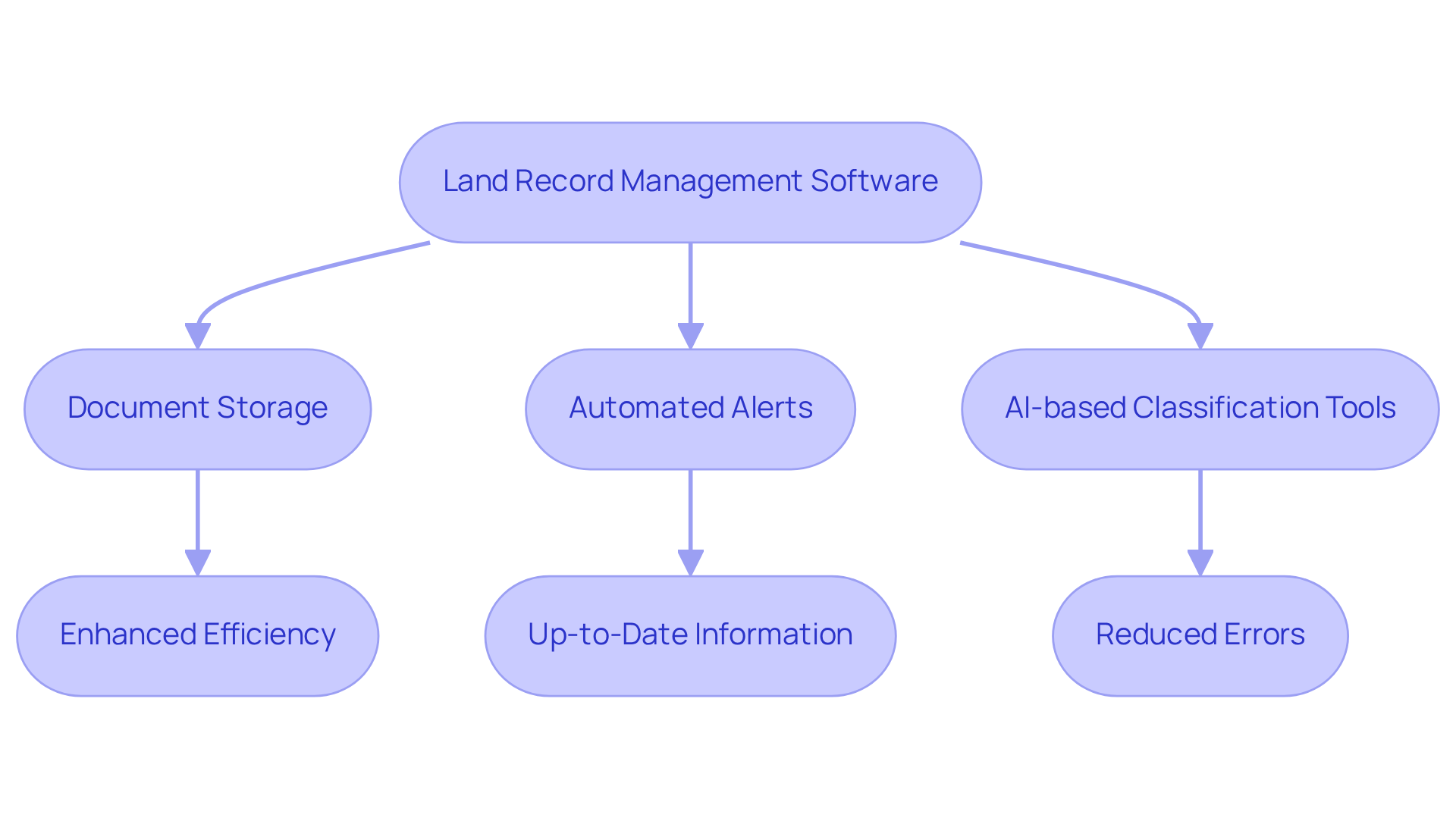
Title Search Automation Tool: Simplifying the Title Research Process
Search automation tools fundamentally transform the research process by streamlining repetitive tasks such as data entry, document retrieval, and report generation. By significantly decreasing the manual workload, these tools empower researchers to focus on critical analysis and informed decision-making. Automation accelerates the research process, enhancing precision by minimizing human errors, which ultimately results in more reliable reports.
For instance, an analytics firm that adopted an Axis Smart Data Extraction solution achieved an impressive 40% reduction in expenses while improving operational efficiency. Furthermore, the integration of Optical Character Recognition (OCR) technology within automated data entry systems has led to a remarkable 90% reduction in data entry errors, underscoring the profound impact of automation on the industry.
As we approach 2025, the momentum towards automating research processes continues to grow, with professionals increasingly recognizing the value of these tools in boosting productivity and client satisfaction. To initiate the implementation of automation tools in your workflow, consider launching a pilot project that targets a specific repetitive task, enabling you to assess the benefits before a full-scale rollout.
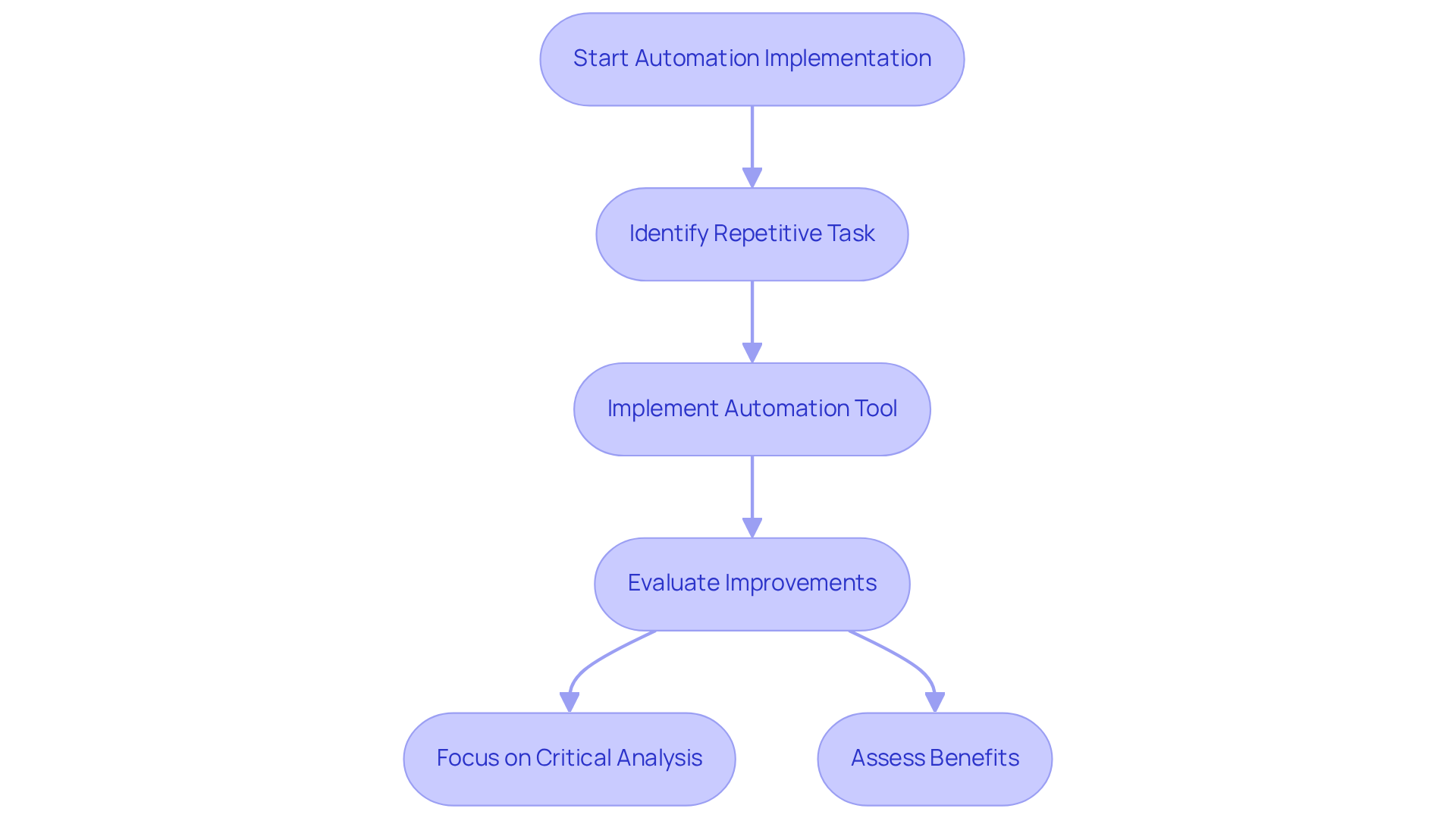
Geographic Information System (GIS) Tools: Visualizing Land Records and Property Boundaries
Geographic Information System (GIS) tools are revolutionizing the representation of land records and property boundaries, while ai-based land records classification tools provide document specialists with enhanced clarity and accuracy in their work. By precisely mapping property boundaries and integrating various information layers—such as zoning regulations and environmental assessments—GIS technology enables comprehensive analyses that support informed decision-making in real estate transactions.
The shift to ArcGIS Parcel Fabric has markedly improved access to reliable information, allowing researchers to accomplish two to three times the workload compared to previous methods. This efficiency not only streamlines workflows but also bolsters the accuracy of property boundary visualizations, ensuring that land records remain trustworthy and current.
Industry experts underscore that effective property boundary visualization is essential for reducing disputes and facilitating smoother transactions. As one expert noted, 'GIS assists decision-makers in visualizing intricate information in spatial format, allowing for more informed, evidence-based choices.'
Furthermore, GIS mapping integrates public records and ownership data to simplify right-of-way negotiations, underscoring the vital role of ai-based land records classification tools in enhancing land management processes. The incorporation of GIS tools into property research exemplifies a commitment to leveraging technology for superior outcomes in land management.
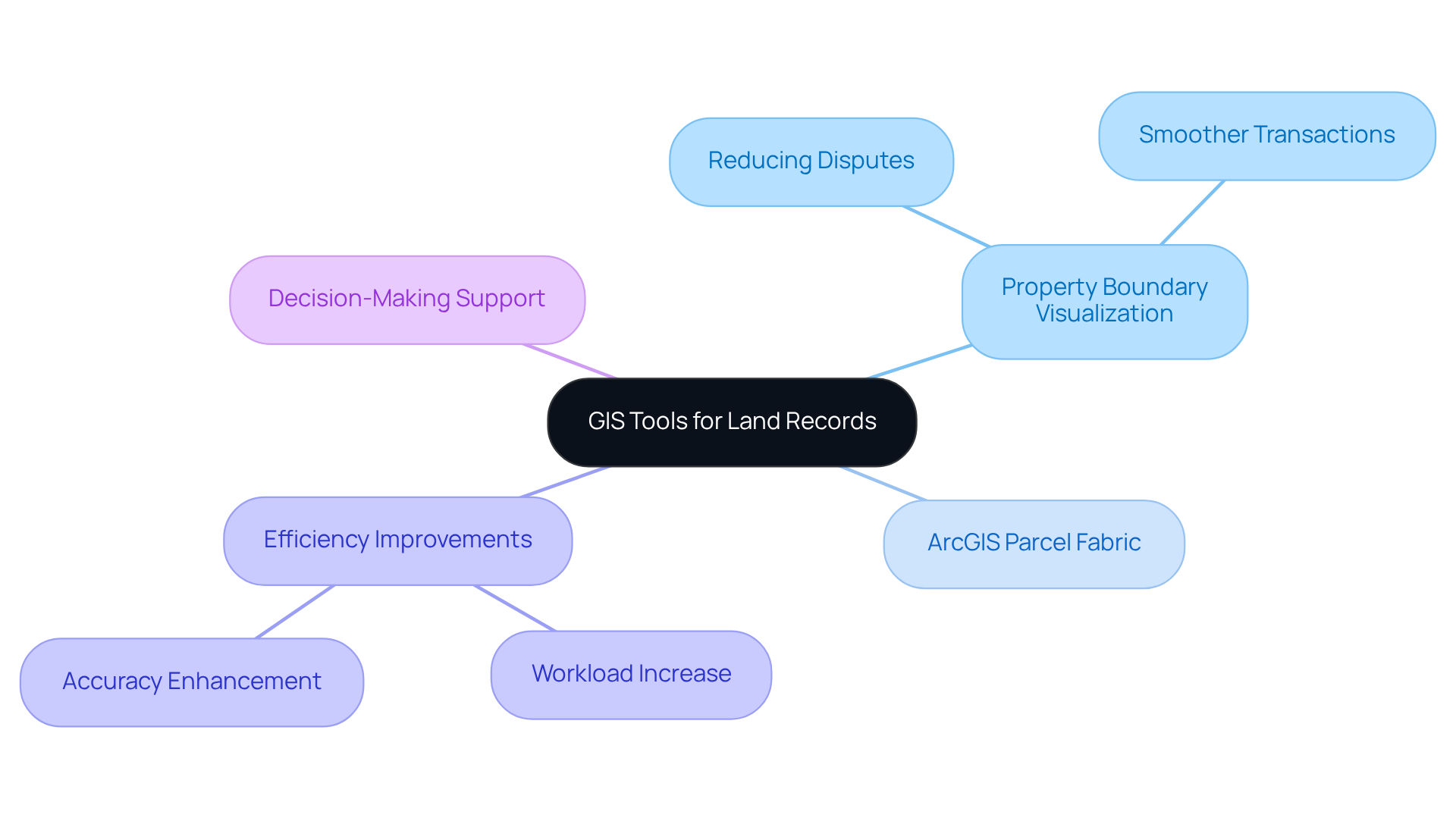
AI-Driven Risk Assessment Tools: Evaluating Property Title Risks
AI-driven risk assessment tools are crucial in evaluating potential risks associated with property ownership. By meticulously analyzing historical data, ownership patterns, and legal documents, these sophisticated systems can quickly pinpoint red flags, such as unresolved liens or inconsistencies in ownership records. This capability allows property investigators to proactively tackle potential issues. For instance, AI can scrutinize historical ownership data to uncover patterns that may indicate fraudulent claims or ownership defects, significantly enhancing the due diligence process.
As we approach 2025, the integration of AI into risk evaluation is transforming the operations of property analysts. This advancement facilitates more informed decision-making and reduces the likelihood of costly errors. Current trends reveal an increasing reliance on AI-based land records classification tools within the industry, with a focus on improving accuracy and efficiency in title risk assessments. Notably, by 2024, around 14% of real estate firms had adopted AI technologies, signaling a substantial shift towards data-driven decision-making.
This transition streamlines workflows and empowers professionals to utilize historical insights for superior risk management, ultimately resulting in more secure property transactions. As industry experts have noted, "AI can accurately predict property price trends with 95% precision, helping investors make smarter and more informed decisions.
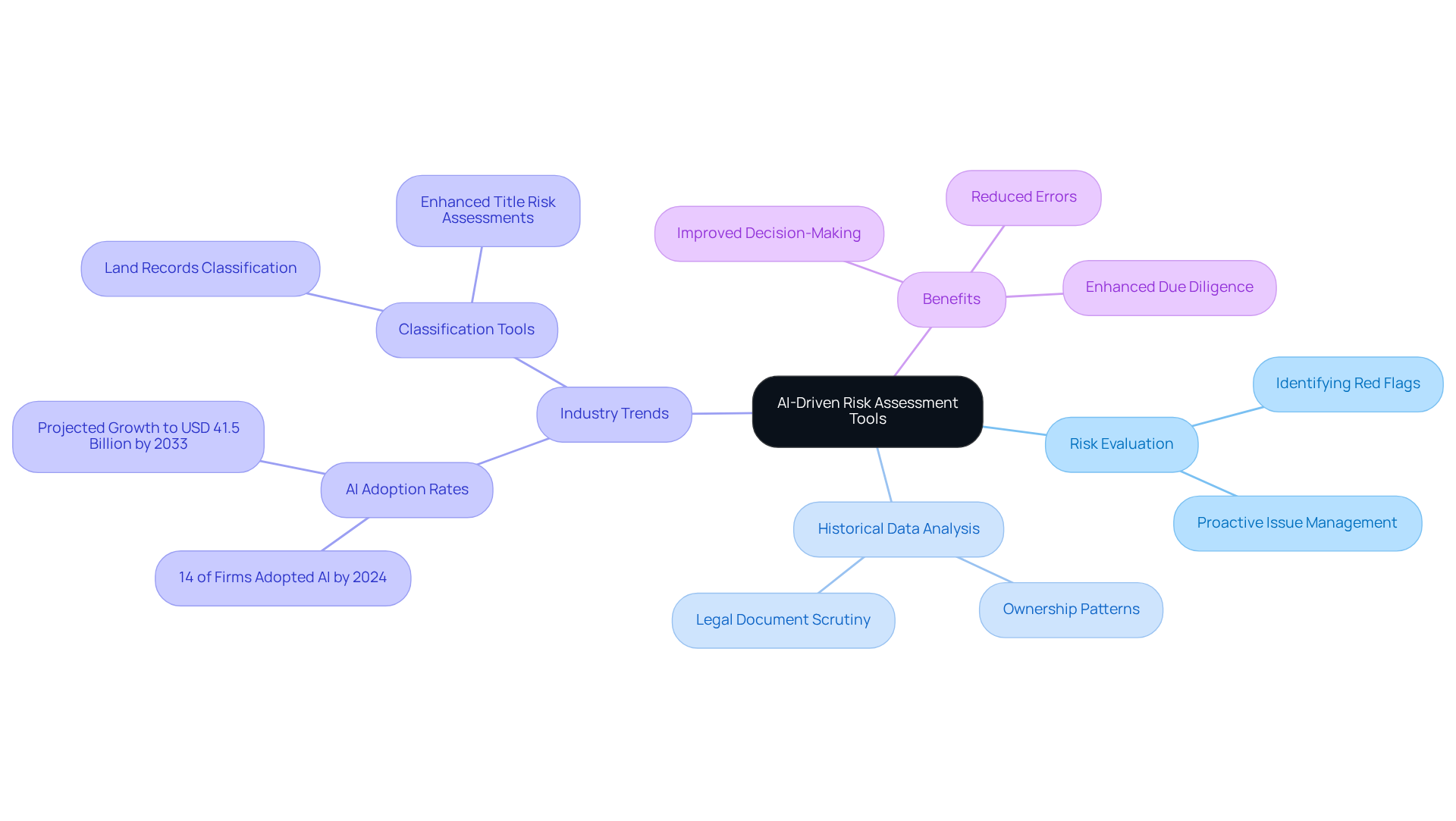
Document Comparison Software: Identifying Discrepancies in Title Records
Document comparison software is indispensable in automating the identification of discrepancies within record entries, empowering analysts to quickly detect inconsistencies. By facilitating side-by-side comparisons of various version files, these tools effectively illuminate differences in language, dates, and ownership details. This functionality is paramount for property researchers, as the preservation of accurate and current records is crucial for maintaining the integrity of real estate transactions.
Industry leaders assert that harnessing such technology not only streamlines the research process but also significantly mitigates the risk of errors that could precipitate costly disputes. Recent advancements in document comparison technology, exemplified by the release of compareDocs 4.2, have further augmented these capabilities, enabling more sophisticated analysis and reporting.
Successful implementations of these tools have demonstrated their efficacy in enhancing accuracy and efficiency in property research, ultimately benefiting all stakeholders involved in real estate transactions.
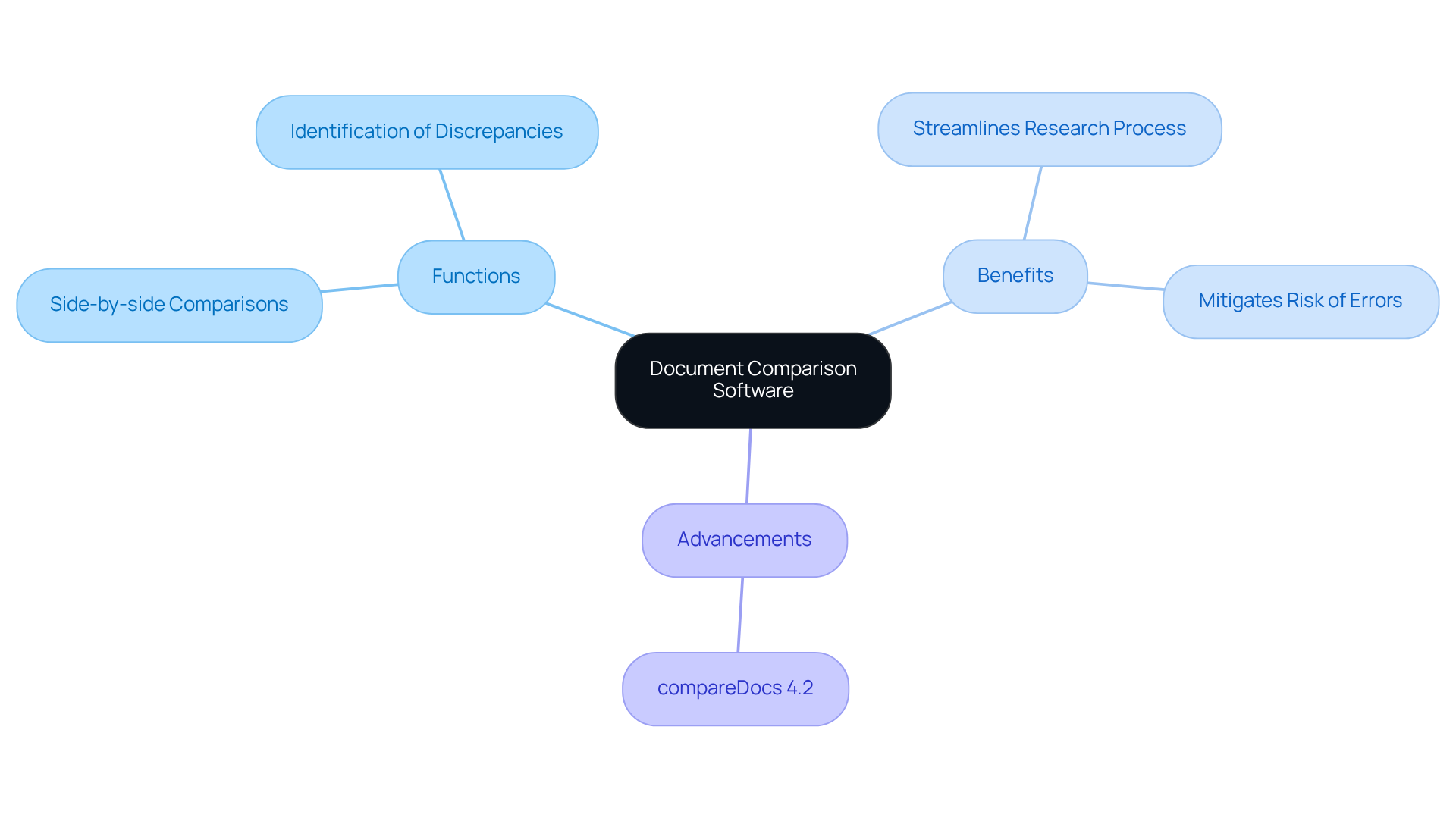
Automated Title Report Generator: Streamlining Title Report Creation
An automated report generator revolutionizes the production of ownership documents by seamlessly gathering relevant information from diverse sources. This technology significantly reduces the time spent on manual report creation, allowing researchers to focus on more valuable tasks. By streamlining the report generation process, these tools guarantee that all essential information is included, resulting in accurate and comprehensive reports delivered to clients with greater speed.
Companies that have integrated automation into their workflows report a remarkable reduction in report preparation time by up to 40%, thereby enhancing overall service quality. As the industry increasingly embraces automation, experts are recognizing its capacity to improve efficiency and precision, with many noting that such advancements are vital for maintaining competitiveness in a rapidly evolving market.
Current trends indicate a rising dependence on AI-driven solutions, including ai-based land records classification tools, which not only optimize report generation but also elevate the overall client experience by providing timely and accurate information. According to McKinsey, firms with standardized reporting practices experience 20% higher performance in financial outcomes, underscoring the critical importance of adopting automated solutions for enhanced results.
Furthermore, ai-based land records classification tools, such as Kira Systems, are currently being employed in the industry to automate document analysis, further illustrating the practical benefits of automation in title research.
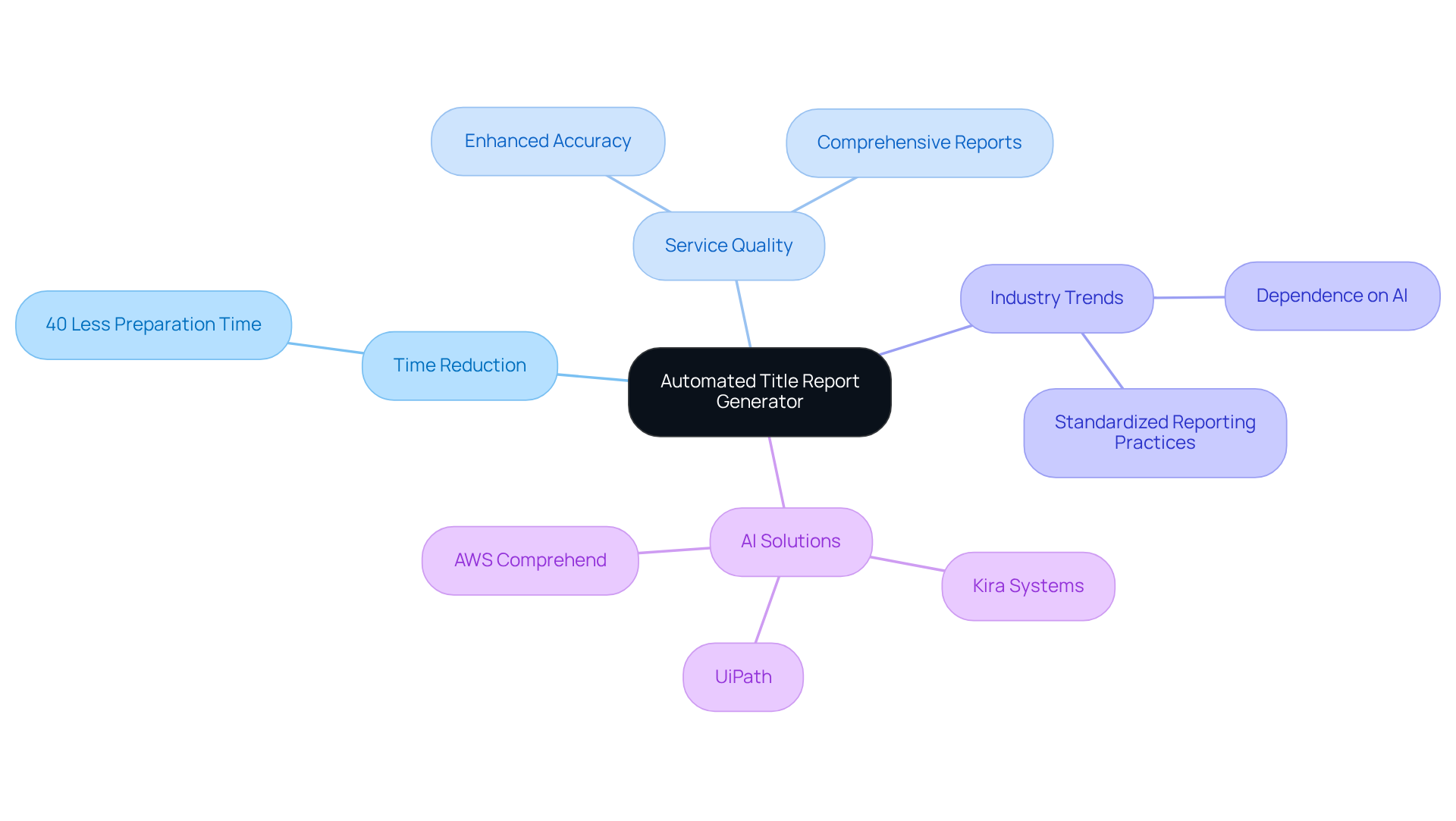
Conclusion
The integration of AI-based land records classification tools is revolutionizing title research, delivering unmatched efficiency and accuracy. As emphasized throughout this article, these cutting-edge technologies not only automate routine tasks but also enable professionals to concentrate on strategic decision-making. In today’s competitive landscape, embracing automation in title research is a necessity, not an option.
Key insights from the discussion highlight a significant reduction in manual errors through advanced technologies such as Optical Character Recognition (OCR) and automated document processing. The advantages of AI-driven document classification systems and geographic information systems (GIS) further illustrate the necessity of leveraging technology to enhance operational efficiency and data accuracy. Moreover, the emergence of automated report generators demonstrates the potential for time-saving solutions that ultimately elevate client satisfaction.
In light of these advancements, it is crucial for professionals in the title research field to actively pursue and implement AI-based solutions. This proactive approach not only streamlines processes but also mitigates risks associated with human error and outdated practices. As the industry progresses toward 2025, adopting these tools will be essential for achieving superior outcomes in land management and property transactions. The future of title research is promising, and those who adapt to these changes will undoubtedly enjoy the benefits of increased efficiency and enhanced accuracy.
Frequently Asked Questions
What is Parse AI and how does it enhance title research?
Parse AI utilizes advanced machine learning algorithms and AI-based land records classification tools to automate the extraction of important details from property records, significantly improving the research process and allowing professionals to focus on high-value tasks.
How prevalent is the adoption of AI-based land records classification tools in the industry?
Approximately 90% of property and escrow specialists have adopted AI-based land records classification tools, indicating a significant shift towards automation in the sector.
What benefits do AI-based land records classification tools provide to escrow firms?
These tools are expected to enhance operational efficiency and stability, helping escrow firms to adapt to future market changes.
How does Parse AI improve document management?
Parse AI facilitates effective document naming conventions, which improve organizational efficiency and reduce the risk of misfiled documents.
What risks are associated with the adoption of AI in ownership research?
Potential risks include increased fraud, which necessitates a balanced approach to integrating AI into ownership research.
What features does the digital interface for searching Comanche County Clerk records offer?
The digital interface provides a user-friendly platform with advanced search functionalities and intuitive navigation, simplifying access to essential land records.
How does the digital interface benefit title researchers?
It allows title researchers to swiftly locate necessary information, reducing the time spent on manual searches and enabling them to finalize reports effectively.
What technology powers the automated document processing for landmen?
The automated processing is powered by Optical Character Recognition (OCR) technology, which converts scanned materials into editable and searchable formats.
How does automation impact error rates in document processing?
Automation can reduce error rates in information entry by up to 80%, compared to a manual entry error rate of approximately 1%.
Can you provide an example of efficiency gains from using OCR technology?
A logistics company that adopted advanced OCR solutions reduced its document processing time from over seven minutes per file to under 30 seconds, showcasing significant efficiency improvements.
Why is minimizing human errors important in research?
The average individual makes about one error for every 1,000 routine activities, highlighting the importance of reducing human mistakes in research to ensure reliable data.




